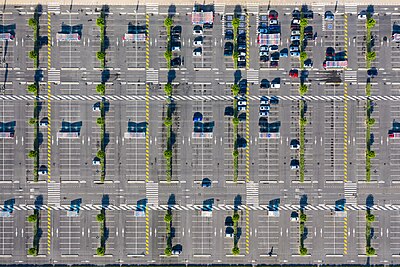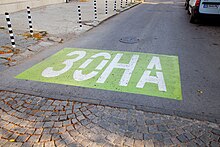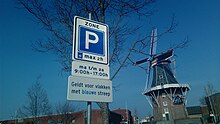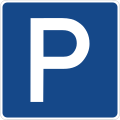parking spot
A parking lot , also known as a parking area , is a publicly accessible area on which road vehicles can be parked . This makes it one of the systems for stationary traffic . In everyday language, the term is used synonymously for all forms of accommodation for parked vehicles. Individual parking spaces , parking stands or a parking space are also referred to as parking spaces .

Public parking spaces are part of the transport infrastructure . The design, capacity and use of parking spaces influence overall traffic and the character of a settlement area, which is why they are also of interest for urban planning . The creation of parking spaces is part of the area of responsibility of traffic planning , and their use is regulated by road traffic regulations , provided it is not private property that is not public . The availability of parking spaces is the subject of public parking space management. These include parking guidance systems and parking management measures , e.g. B. the collection of parking fees or resident parking .
Terms
In road traffic law , a parking lot is an area in public space on which parking e.g. B. is allowed by signage or marking .
In road planning , a parking lot is a ground-level, uncovered, publicly accessible area set apart from the street, which is primarily used to park vehicles. A parking lot consists of the individual parking spaces , the access roads and possible additional facilities, e.g. B. Parking ticket machines. The connecting routes within a parking lot are called tramlines . In contrast to multi-storey car parks and garages , the vehicles are parked in a parking lot in the open air, otherwise the terms and parking spaces hardly differ.
Parking areas on private property outside the public traffic area are parking spaces and are subject to different regulations than public parking spaces. The exact legal term and the corresponding requirements are set out in the parking space regulations
All parking areas within an area are collectively referred to as parking space . The overriding consideration and influencing of parking space, its availability and management is the task of parking space management .
Differences between parking spaces
Parking areas can be designed very differently. The implementation is determined in individual cases by many things, such as the available space, the funds, the intended use or the legal regulations. The following list divides parking areas according to different perspectives. However, this assignment is not always clear, so several of the categories can match a parking space at the same time. For example, a parking lot near a train station could serve both as a P + R parking lot and as a customer parking lot for shops . There could also be separate areas for cars , motorcycles and bicycles .
Classification according to location in the road network
Parking areas are always connected to the road network. Depending on the type of connection, a distinction can be made between parking spaces in the narrower sense and parking spaces in the street.
Remote parking spaces
Parking spaces outside the public street are accessible via their own driveway. The available space and the usage requirements result in different divisions of the parking area, if any division is marked . The type of parked vehicles, the position of the vehicle and the width of the tramlines primarily determine the number of available parking spaces or spaces. Parking spaces can have different surfaces as long as the surface is sufficiently passable. Often green areas and trees are also integrated into the design of the parking spaces in order to shade the parked vehicles and to structure the areas.
Fenced car park in Moscow
Snow-covered car park in Igls , Austria, 1960
Large car park at the port of Kadıköy , Turkey
Parking areas along streets
Designated parking areas on streets without their own access roads are called parking lanes . The areas are part of the cross-section of the street , they can be shown on the edges of the lane, on the median, and partially or completely on sidewalks . A distinction is also made between different types of vehicle installation for parking lanes. Short parking strips delimited by green spaces, trees or curbs are called parking bays , parking pockets or parking harbors (especially in the Berlin area). In order to make better use of the parking lanes, the individual parking spaces are often marked with lane markings.
If no parking lane is shown on a street, parking in Germany is permitted according to § 12 StVO on the right edge of the lane, provided the situation is observed. In traffic-calmed areas, on the other hand, you may only park within the designated areas.
Areas in public space that are used for loading and unloading delivery vehicles are referred to as loading zones . In addition to the parking spaces, loading zones can also include areas for depositing loads and maneuvering areas.
Parking inclined on a street in Port Said , Egypt
Different parking lanes for cars in Wettingen
Cars parked on the roadside in Flores , Guatemala
Parking lanes for motorcycles in Spain
Loading zone in Paris designed as a parking bay
Parking areas for various vehicles
There can be parking stalls or parking spaces for different types of vehicles in a parking area. Markings and signs usually make it clear which vehicles should park where.
Car parking
Parking spaces for cars are certainly the most common type of parking. There are car parking spaces wherever people are driving. There are different dimensions for parking spaces around the world; a measurement vehicle can be used to determine the size . In Germany, the following sizes are common for newly created parking spaces:
| Lineup | width | length | source |
|---|---|---|---|
| Longitudinal parking stand | 2.00 m regular
2.30 m at boundaries |
5.70 m for reverse parking
6.70 m for forward parking |
EAR |
| Parking stand in oblique and vertical arrangement | 2.50 m regular
2.85 m with one-sided boundaries 2.90 m with boundaries on both sides |
5.00 m | EAR |
| Private parking spaces | 2.30 m - 2.50 m | 5.00 m | * |
Some car parking stands are equipped differently or are signposted to meet special needs. So there is something like:

- Disabled parking spaces, the parking spaces of which are slightly wider so that a wheelchair can be accessed by the car.
- Parking spaces with charging stations for electric cars .
- Parking spaces for women , which are often close to exits in parking garages.
Truck parking
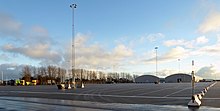
Specially designated truck parking spaces are particularly common on motorways .
Bicycle parking
Bicycles are usually parked so that they can be leaned against and connected. That is why parking areas for bicycles are often equipped with leaning bars, front wheel holders or similar devices.
Bus parking
Bus are particularly in the area of railway stations , airports , major hotel resorts, sports stadiums , meeting - and conference centers , of cultural facilities, tourist attractions or landmarks required. In many tourist cities, special bus parking spaces are therefore designated.
Motorcycle parking
Motorbike parking spaces are often small parking areas close to the city center (usually only 2 to 15 parking spaces) which are released by a sign or a marking for motorcycles (also with sidecars) and mopeds or mopeds.
Classification according to use
Regardless of their layout or design, parking spaces can also be subdivided according to special uses. The terms are not always used consistently.
Customer, guest or visitor parking
These parking spaces are often operated by companies on private property. Nevertheless, they can be part of the public traffic area if they are freely accessible. The parking areas can be used for the duration of shopping or visiting, often free of charge. This means that people can park conveniently close to their destination and do not have to look for a parking space. In most cases, the permitted usage times are limited and the access roads are provided with barriers . Use outside of business hours is not explicitly allowed, but is often tolerated.
Parking spaces as part of rest areas and rest stops

Motorway service stations and rest areas (also known colloquially as motorway parking spaces) are facilities on motorways and other trunk roads where travelers can rest. In order to be able to park the vehicles there, there must be a sufficient number of parking spaces. At rest areas, road users can meet their supply and disposal needs and take breaks. The equipment of rest areas often includes benches and garbage cans , sometimes there are also sanitary facilities or a children's playground . If additional facilities such as a gas station or a restaurant are connected to the rest area, it is called a motorway service station.
Park and ride parking

These parking spaces serve to link private and public transport . They are close to train stations, airports and local transport stops so that people can switch between private vehicles and public transport. The distance between the parking lot and the bus stop should be as short as possible. Parking spaces for bicycles with the same function are called bike-and-ride facilities. A further development of the park-and-ride facilities are the mobility stations , at which shared vehicles ( car sharing , bike sharing , etc.) can be parked. Kiss-and-ride facilities are usually not parking spaces as the vehicles only stop there for a short time .
Car park
At Mitfahrparkplätzen can carpools meet, waiting for each other or turn off vehicles.
Hikers 'parking lot or hikers' parking lot
In Germany, this is the name given to parking spaces that are primarily intended for hiking tourism . They are mostly located outside of settlements in local recreation areas or regions of interest to tourists. By creating such parking spaces at important points of the network of hiking trails, parking z. B. be prevented at roadsides. The parking lots are often the starting point for hiking trails, and motorist circular hiking trails also lead back to the same parking lot. Hiking parking lots often have garbage cans to avoid littering . Other typical equipment are benches or information boards. The Wanderparkplatz sign was first published under this name on April 7, 1967 in the traffic gazette of the Federal Ministry of Transport. With the amendment to the Road Traffic Regulations from 1992, the name was changed to Wandererparkplatz. This designation is still mandatory in official language today, in everyday language the facilities are also called hiking parking lots.
Temporary parking space
If there is insufficient parking space for events, temporary parking spaces are often used. B. set up on meadows or fields . As a rule, these areas are not or only to a minor extent, and there are no parking area markings. At major events, the cars are sometimes directed to available areas using specially installed guidance systems .
Parking zone
A parking zone is a designated area in which different parking rules apply. The cities want to influence the use of parking spaces ( parking space management ). The exact regulations differ depending on the city and country. Some cities, e.g. B. Prague , Sofia , Essen or Barcelona also have several parking zones with different rules and tariffs. Parking zones are often combined with residential parking .
Germany
According to § 13 StVO, the arrival time in a parking zone must be indicated with a parking disc ; the specified parking time must not be exceeded. Parking fees may also be charged.
The signs for a parking zone developed from the parking zone and the blue zone . Two signs are now possible, the parking management zone and the restricted no- parking zone. In combination with additional symbols, all parking regulations can be implemented.
Austria
In Austria there are short-term parking zones or blue zones in which parking is only permitted for a certain period of time. There parking can either be free (then only with a parking disc) or paid.
Switzerland
The parking zones in Switzerland are called the Blue Zone and are marked with a blue marking. Vehicles can park there for one hour on weekdays between 8 a.m. and 6 p.m. with a parking disc.
Netherlands
In parking areas with a blue marking, parking is only permitted with a parking disc.
Effects
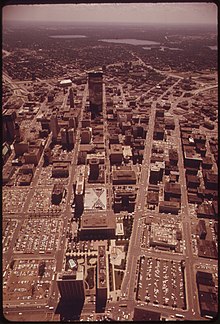
Parking spaces were created as a by-product of an increasingly mobile and motorized society. In a car-friendly (urban) landscape , all facilities need car parking spaces nearby so that they can be reached by car. For many companies with public traffic, parking spaces were and are an important economic factor. With the turnaround in traffic, the effects of this development are being viewed increasingly critically. The traffic researcher and activist Hermann Knoflacher said:
"The solution to traffic problems occurs with people and those closest to them - the parking lot."
In Germany, private cars are parked on average around 95% of the day, i.e. over 23 hours a day, in parking spaces. Similar numbers can also be observed in other countries. This means that considerable parts of the traffic area are required for parking spaces. In Hanover, parking spaces occupy over 15% of the urban area, making it the largest proportion in Germany. Parking spaces have a visible impact on the cityscape and are often perceived as unattractive and annoying. With their large asphalt surfaces, parking spaces also act as heat islands . In large cities, the conflict of interest over parking spaces is particularly evident, as the public areas are limited in size but are used intensively. Interest groups such as the ADFC are promoting, for example, that cities do not offer their car parking spaces free of charge in order to create more space for cycling .
Availability of parking space
At least one parking space is required at the end of the journey for all journeys that are made with a private vehicle (i.e. individual transport). People prefer short distances from the starting point to the vehicle and from the vehicle to the destination. From this point of view, free, inexpensive and inexpensive parking spaces are ideal. The availability of parking spaces is also a decisive factor for the attractiveness and use of the means of transport.
Parking demand and availability
The availability of parking space is determined by supply and demand . If the parking spaces in an area are often full or overloaded, one speaks of (high) parking pressure , colloquially also of a parking space shortage or parking space shortage . One consequence can be an increasing number of incorrectly parked vehicles.
The demand for parking space depends on the various requirements of use, the parking behavior. This in turn is the nature of the surrounding buildings influenced, in a residential area such predominates. B. the demand of the people living there. The parking requests differ mainly in the parking duration and the frequency of parking processes. The following usage groups can be distinguished according to their parking behavior:
- Residents park for a long time ( long-term parkers ), and vehicles often leave the residential area during the day.
- In the professional and educational traffic , people often do not park for several hours, but usually at night.
- Parking times are very short for shopping and errands, the demand depends on the opening times of the surrounding facilities.
- The delivery and commercial traffic needs above all areas close to its destinations, the parking time is rather short.
- Visitor traffic is highly dependent on the type of event or facility attended.
The parking space offer includes all parking spaces in an area with the conditions applicable there. It can be changed by either creating new parking spaces or dismantling existing parking spaces. In addition, the form of management means that parking spaces can be used more efficiently.
Finding a parking space
The search for a free parking space causes costs in the form of fuel costs, damage to health, damage to the environment and loss of time and frustration. In a small business district of Los Angeles, 180,000 liters of gasoline are used annually just to find a parking space, which is burned to 730 tons of CO 2 . The parking search traffic makes according to former Federal Transport Minister Alexander Dobrindt of 40% of traffic in the cities. According to a study commissioned by the Research Association for Automotive Technology , a total of around 560 million hours of searching for a parking space are spent every year in Germany. In extreme cases like 2019 in Los Angeles , two people argued for an hour and a half over a free parking space.
Influencing by parking space management and parking space concepts
The generic term parking space management summarizes several measures with which municipal administrations can influence the availability of parking space. A plan to define such measures is also called a parking space concept . Car traffic in cities is to be shifted to other means of transport and made more tolerable by means of parking space concepts . The main ways to influence are
- the parking space management
- the long-term management of the parking space supply, both
- directly by adjusting the number of parking spaces in the street
- indirectly by adapting parking space requirements in building law and parking space regulations, or by promoting shared garages
- influencing parking demand through control and information systems
Occasionally, parking space management only refers to the management and supply control.
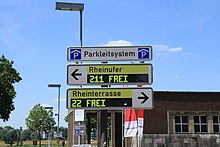
Information systems and parking guidance systems
Information systems should guide car traffic to free parking spaces in order to shorten the search for a parking space and to use the parking space more efficiently. The information can be disseminated through signs, digital displays, or internet-based systems. Many cities in industrialized countries have such a parking guidance system for free parking spaces. American cities, first and foremost San Francisco, planned from autumn 2008 to record not only the parking spaces in multi-storey car parks, but also in chargeable parking bays (initially 6,000 of 24,000). The occupancy should be displayed on display boards and be accessible via mobile phone or navigation system . Similar systems also exist in Swiss cities. In the city of Zurich , for example, various parking garages and public parking spaces are recorded in the parking guidance system. This can be accessed on site (using display boards), online and by mobile phone.
Conversions

Public parking spaces are part of the urban space that can be redesigned by the public sector. Today, car parking spaces are no longer viewed positively in terms of sustainable, gentle mobility . Therefore, parking spaces are repeatedly reduced or converted, e.g. B. as a green area , recreation area, for a bus lane or a bike path . Such measures are often controversial because traders or people living there see disadvantages for themselves.
In the course of campaigns such as Parking Day , parking spaces are being converted for a limited time. This is to draw attention to the space that car parking spaces take up in a city. Parklets , on the other hand, are mostly permanent small parks on former car parking stands.
Planning and construction
Situation in Germany
The recommendations for systems for stationary traffic (EAR) apply to the design of new public parking spaces in Germany .
Signage and marking
Internationally, through international treaties such as the Vienna Convention on Road Traffic Signs , the parking lot sign with the letter “P” (in Latin America often also “E”) in white on a blue background has become established. The round no- parking sign with a red border and a diagonal red bar on a blue background is also widespread . The exact designs, meanings and applications can nevertheless differ internationally. In some countries, such as For example, in the United States or Brazil , other signs are also used in principle.
Positive and negative signage
Parking areas can be defined both positively with parking lot signs and negatively with parking bans.
- Positive signs in various designs
Sign "Parking allowed" in Switzerland and Liechtenstein
Austrian sign "Parking"
Sign "Parking" in Indonesia
Sign "Parking Allowed" in Chile
Sign "Unrestricted Parking" in Australia
- Negative signs (no parking) in different designs
No parking sign in Finland
No parking sign in South Korea
No parking sign in the countries of the Southern African Development Community
No parking sign in Ireland
Parking signs and no parking signs with additional restrictions, additional signs
In almost all countries there are signs that regulate the use of the parking areas more precisely. In the simplest case, additional arrows show the direction for which the signs apply. In some countries there are additional symbols or additional signs that z. B. can be attached together with parking lot signs or no parking signs and thus specify the validity. The signs often convey information about
- the direction of action (seen from the location of the sign)
- the parking time
- the period of use
- the type of use
- the type of vehicles
- parking space management
- the exemptions
- Etc.
No parking on odd days, here from Belarus
Japanese sign for parking in an inclined position
Handicapped parking space on the left with a 30 minute maximum parking time sign from New Zealand
Zone signage
Parking zones are either defined by a sign or a marking at the beginning and end of the zone or by different colored parking area markings.
Markings
Road markings are also used to mark parking areas or areas where parking is prohibited. Depending on the country and zone, the markings can only define a parking space or a parking ban in connection with traffic signs or on their own.
Marking of a taxi stand in Switzerland and Liechtenstein - there is no parking for private cars.
Marking with different colors of the plaster, here at a disabled parking lot in Indonesia
Motorcycle parking lot in Bad Wildungen with a marked pictogram , paved boundaries and a sign with additional symbols
Signage in individual countries
Germany
- Different representations for a parking lot sign in Germany
Sign 316:
Park and TravelSign 314.1:
Start of a parking space management zoneSign 229:
taxi standExit to a motorway parking lot
Sign 314-50:
multi-storey car park , parking garage
Depending on the type and function of the parking space, the sign can be supplemented with additional signs (e.g. resident parking ) or used in a modified form.
- Exemplary representation of possible additional characters
Sign 1040-32:
2 hours only with parking disc
Trivia
A public parking lot under street lamps is also jokingly referred to as a "lantern garage" - it is considered to be "better" because it is more theft-proof.
See also
Web links
Individual evidence
- ↑ a b c d e f g h i Research Association for Roads and Transportation - Cross-Sectional Committee Definitions: Definitions - Part: Traffic planning, road design and road operation . Edition 2012 edition. FGSV-Verlag, Cologne 2012, ISBN 978-3-86446-024-1 ( fgsv-verlag.de [PDF; accessed on October 16, 2019]).
- ↑ a b c d e f Research Society for Roads and Transportation. Road design working group: EAR 05 - Recommendations for systems for stationary traffic. FGSV-Verlag, Cologne 2012, ISBN 978-3-7812-1632-7 .
- ↑ a b Uta Bauer, Martina Hertel, Robert Sedlak: Parking management is worth it! Guide to communication and administrative practice . Ed .: Agora Verkehrswende. February 2019, p. 7–9 ( agora-verkehrswende.de [PDF]).
- ↑ FOOT eV : Legalized sidewalk parking. Retrieved November 9, 2019 .
- ↑ Elmar Schütze: Parking Day Flashmob: Front garden idyll in the Parkhafen. September 20, 2013, accessed on November 9, 2019 (German).
- ↑ Motorcyclist crashes into a car. February 18, 2019, accessed on November 9, 2019 .
- ↑ Appendix 3 StVO 2013 - individual standard. Retrieved October 28, 2019 .
- ↑ Application of the StVO rules and the StVG standards in parking lots and in multi-storey car parks. Retrieved November 9, 2019 .
- ↑ work team P + R VDV-Planning Committee: design, planning and operation of P + R . Ed .: Association of German Transport Companies . February 1993, p. 28 ff .
- ^ Verkehrsclub Deutschland : Mobility stations. September 24, 2019, accessed November 4, 2019 .
- ↑ Traffic signs for parking spaces for hikers . In: Verkehrsblatt 1967, No. 128, p. 298.
- ↑ Verkehrsblatt , 1, 1992, p. 188.
- ↑ Traffic signs in the traffic sign catalog - list of official designations. (PDF; 76 kB) Federal Highway Research Institute, April 2017, accessed on November 19, 2018 .
- ↑ Wanderparkplatz, der. In: Duden. Retrieved November 19, 2018 .
- ^ Helena Šulcová: There is no parking space in Prague! Mitteldeutscher Rundfunk , June 17, 2019, accessed on November 26, 2019 .
- ^ City of Essen: Parking zones and parking fees. Retrieved November 23, 2019 .
- ↑ Everything you need to know about parking in Barcelona. In: ShBarcelona. March 22, 2016, accessed November 23, 2019 .
- ↑ General German Automobile Club , department traffic (ed.): The traffic show . Munich 2017, p. 63 f . ( adac.de [PDF]).
- ↑ Parking in Vienna and Austria: Regulations & Information. Retrieved November 23, 2019 .
- ^ Adrian Küpfer, Maria Kressbach: Parking in the blue zone: this is how it works. Swiss Radio and Television SRF, April 4, 2018, accessed on November 23, 2019 (Swiss Standard German).
- ↑ Foreign Office: Netherlands: Travel and Safety Instructions. Retrieved November 23, 2019 .
- ↑ Knoflacher, Hermann: Standing witness - vehicles: the jam is no traffic problem . Böhlau, Vienna 2001, ISBN 3-205-98988-0 , p. 10 .
- ↑ infas, DLR , ivt (Ed.): Mobility in Germany 2017 - Results report . Bonn February 2019, p. 76 ( mobilitaet-in-deutschland.de [PDF]).
- ↑ Martin Randelhoff: The greatest inefficiency of private car ownership: Parking. In: future mobility. March 25, 2016, accessed November 16, 2019 .
- ↑ Parked cars: In these cities, cars take up most of the space. October 8, 2016, accessed November 16, 2019 .
- ↑ Looking for a parking space? Cities are developing new smart and green solutions. In: URBAN HUB. January 31, 2018, accessed on November 26, 2019 (German).
- ^ ADFC General German Bicycle Club e V: 21.09. Park (ing) Day - ADFC: “Parking has to be significantly more expensive!” September 21, 2018, accessed on December 7, 2019 .
- ↑ Apel, Dieter, Lehmbrock, Michael: Urban compatible traffic planning: Opportunities to control car traffic through parking space concepts and management . German Institute for Urban Studies , Berlin 1990, ISBN 3-88118-162-8 , p. 28 .
- ^ City of Regensburg - City Planning Office: Strategic concept parking in the city center. May 2017, p. 8 f. , accessed on November 11, 2019 .
- ^ Paul Widmer: Influence of the parking offer on the traffic behavior. Swiss Association of Transport Engineers and Transport Experts , January 15, 2019, accessed on November 11, 2019 .
- ↑ Apel, Dieter, Lehmbrock, Michael: Urban compatible traffic planning: Opportunities to control car traffic through parking space concepts and management . German Institute for Urban Studies , Berlin 1990, ISBN 3-88118-162-8 , p. 23 f .
- ↑ Parking behavior of residents. Research Information System for Mobility, Traffic and Urban Development , October 11, 2018, accessed on November 13, 2019 .
- ↑ Parking behavior of work and training traffic. Research Information System for Mobility, Traffic and Urban Development , November 11, 2018, accessed on November 13, 2019 .
- ↑ Parking behavior of shopping and processing traffic. Research Information System for Mobility, Traffic and Urban Development , March 6, 2019, accessed on November 13, 2019 .
- ↑ Parking behavior of delivery and commercial traffic. Research Information System for Mobility, Traffic and Urban Development , November 11, 2018, accessed on November 13, 2019 .
- ↑ Parking behavior of visitor traffic. Research Information System for Mobility, Traffic and Urban Development , November 11, 2018, accessed on November 13, 2019 .
- ↑ Influencing the available parking space. Research Information System for Mobility, Traffic and Urban Development , January 14, 2019, accessed on November 15, 2019 .
- ↑ Dr. Gerald Schneider, Hubert Obermaier, Markus Peherstorfer: Auto industry in "very difficult waters". In: Straubinger Tagblatt . Federal Ministry of Transport and Digital Infrastructure , September 9, 2017, archived from the original on July 30, 2018 ; accessed on November 11, 2019 .
- ↑ Prognos AG : Information about available parking spaces in cities . In: Forschungsvereinigung Automobiltechnik (Ed.): FAT series of publications . No. 271 . VDA, 2015 ( vda.de [PDF; accessed on November 11, 2019]).
- ↑ Elisabeth Kochan: She films the stubborn struggle for a parking space - one and a half. Hours. Long. In: Watson . April 4, 2019, accessed November 11, 2019 .
- ↑ Apel, Dieter, Lehmbrock, Michael: Urban compatible traffic planning: Opportunities to control car traffic through parking space concepts and management . German Institute for Urban Studies , Berlin 1990, ISBN 3-88118-162-8 , p. 58 f .
- ↑ Senate Department for Urban Development (ed.): Guideline for parking space management . December 2004, p. 3 f . ( berlin.de [PDF; accessed on November 9, 2019]).
- ↑ Parking management. City of Munich - Department for Urban Planning and Building Regulations, accessed on November 9, 2019 .
- ↑ ??? (No longer available online.) Formerly in the original ; accessed on November 16, 2016 . ( Page no longer available , search in web archives ) ZDF July 22, 2008
- ↑ Parking guidance system City of Zurich , pls-zh.ch
- ↑ Britta Bielefeld: "Existential": 78 parking spaces should go - downtown dealers are angry. In: Göttinger Tageblatt . October 17, 2019, accessed December 7, 2019 .
- ↑ Bert-Christoph Gerhards: Parking spaces are no longer available: residents criticize the redesign of Rheindorfer Platz. In: Kölner Stadt-Anzeiger . November 20, 2018, accessed December 7, 2019 (German).
- ↑ Anna Schmatz: In Stuttgart-Ost 35 parking spaces are no longer available: residents angry about the bus lane. In: image. October 26, 2019, accessed December 7, 2019 .
- ↑ Home - PARKingDay Berlin. Retrieved December 7, 2019 .
- ↑ A parking ban creates a dispute with the authorities. In: Rheinpfalz. July 25, 2016, accessed November 5, 2019 .
- ↑ Laternengarage , Duden , accessed on July 4, 2011.

